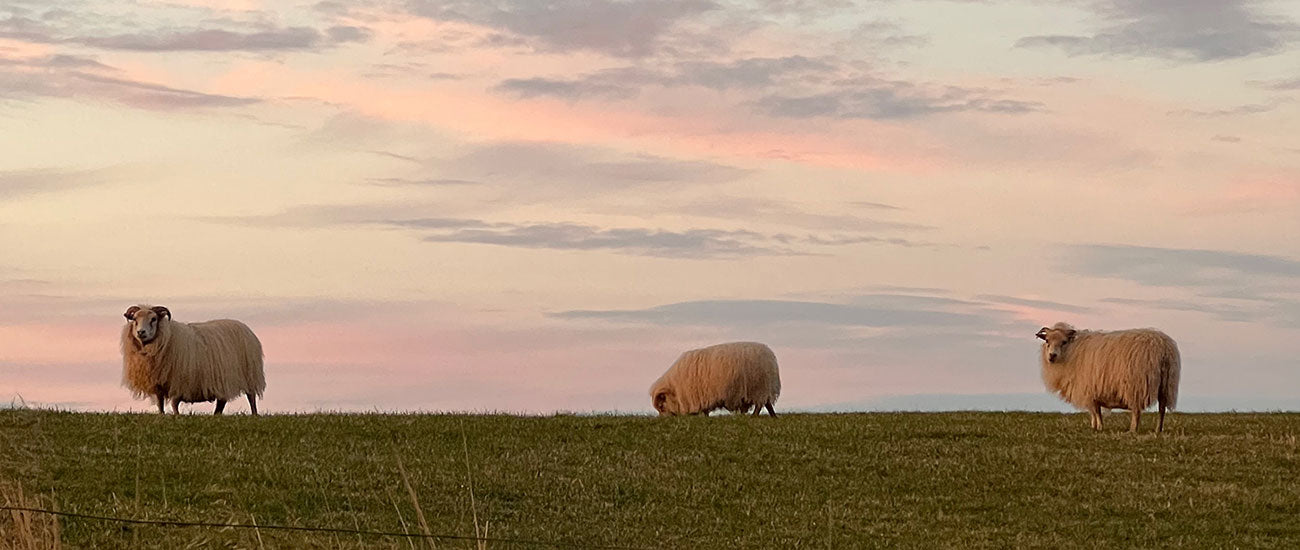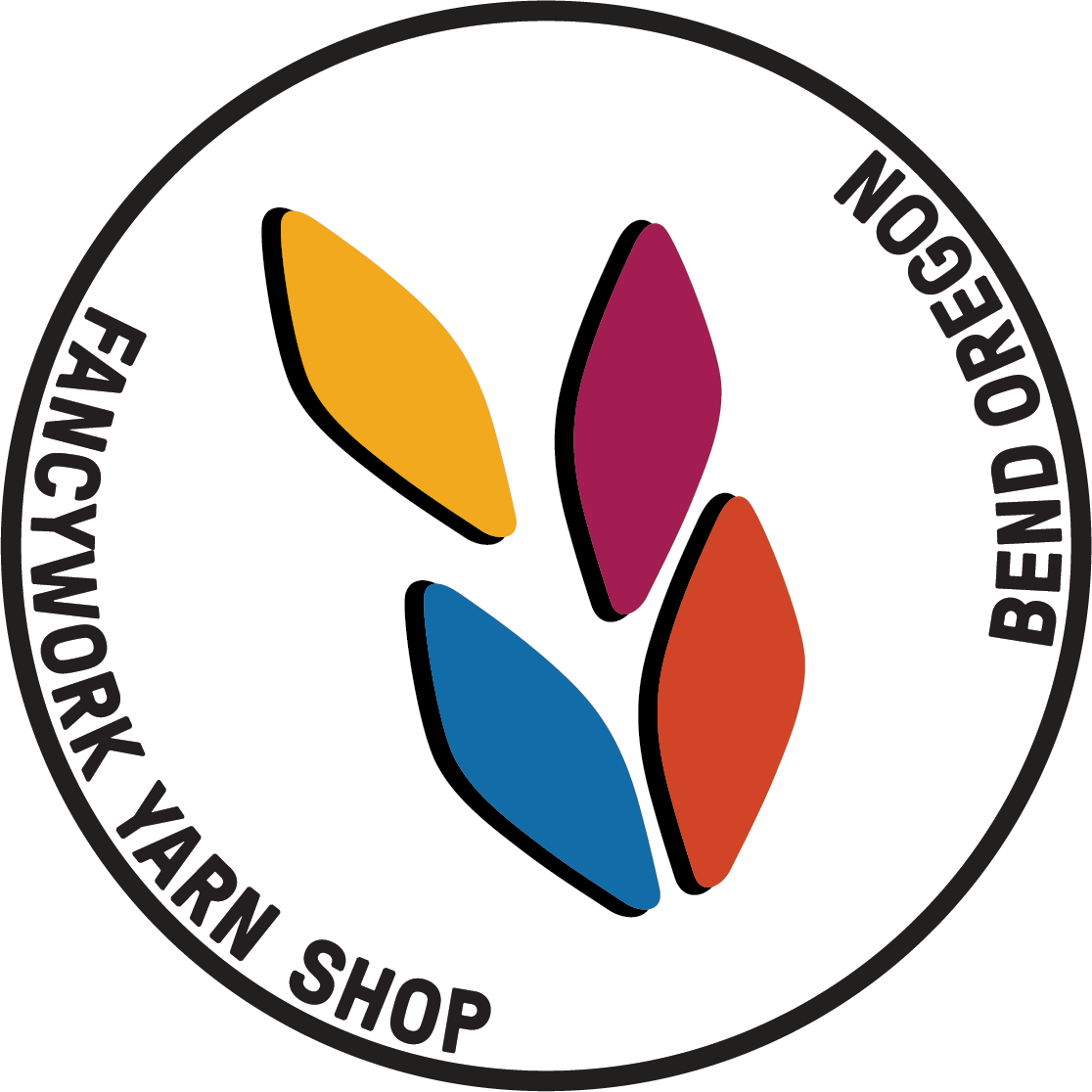
The Original Outerwear: Icelandic Wool
I recently returned from a positively glorious trip to Iceland where I learned all about traditional Icelandic Lopi sweaters and Icelandic wool. Let me start off by saying that if you have a chance to go to Iceland, you really should. I fell in love with the country the moment I stepped off the plane. Iceland is an island like no other with its stunningly stoic landscape, immense glaciers, steamy geothermal waters, and saga-filled history. And to top it all off, the countryside is dotted with curly-horned sheep, plump with wool.
The unique Icelandic Sheep

The Icelandic is a very special breed in the world of domestic sheep. Icelandic sheep have been providing Icelanders, quite literally, with the gift of survival ever since the breed was introduced to the island with the arrival of Norse settlers in the 9th century. These ungulates provided sustenance as they were originally raised for milk production and later for meat. Faced with a lack of wood on a largely treeless island, the settlers heated homes and cooking fires by burning sheep dung. In fact, sheep dung is still used in food processing smokehouses today. Nothing was wasted from sheep: skins, leather, bone, meat, and wool were all used for survival in a harsh environment.
The Icelandic sheep remains largely unchanged over the last twelve centuries. Owing to its isolated home, the Icelandic sheep has the renowned status of being the purest population of livestock in the world. It is also among the hardiest. 1,200 years of evolution in Iceland’s cold, windswept environment has developed an animal capable of surviving extreme weather – and a wool coat that makes that possible.

An Icelandic sheep’s fleece contains two distinct types of wool, an outer fleece called the tog and an inner fleece called the thel (þel). The tog is the long guard hair that provides the sheep with a water resistant outer layer. These fibers contain a thin water-repellent casing that causes moisture to shed off the outermost layer, keeping the inner layers dry. What doesn’t simply roll off is absorbed through tiny holes in the tog fibers. A tog fiber can absorb up to 40% of its weight in water without feeling soaked. The absorbed moisture then evaporates before even being noticed by its host.
It’s almost as if there are two sheep in one: the first weather resistant, the second soft and warm. This double coat is a trait that has been bred out of most other breeds of sheep in the world. Less relevant to us fiber crafters, but surely of great interest to the sheep, is that if left entirely alone, an Icelandic sheep’s coat would shed each year, unlike most other breeds that MUST be shorn annually if they are to be able to carry their own weight. Remember Shrek, the sheep who escaped shearing for 6 years?
The unique qualities of Icelandic wool make it especially valuable to the textile industry. Icelandic wool is used for blankets, bedding, home goods, insulation, outerwear, inner wear, and everything in between. What this means for knitters and crocheters is that Icelandic wool provides something no other wool fiber can – a complete outerwear system to work with.
The History of the Lopi Sweater

The initial design that spurred the iconic Icelandic round-yoke sweaters was inspired by the national costumes worn by women in Greenland. In the 1930s, Norwegian designer Annichen Sibbern Bøhn created a sweater called Eskimo. Around the same time, designers from other Scandinavian countries came up with their own versions of the round yoke sweater. Icelandic designers and knitters added to the trend by knitting them entirely by hand – a practice still continued to this day – and exclusively with Icelandic wool, of course. The result was a beautiful sweater that is also functionally protective.
In fact, for many rural Icelanders the lopapeysa, as they are properly known, was – and still is – the garment of choice for most seasons outdoors. It was functional fashion – the workwear favored by farmers but generally spurned by city dwellers in Reykjavik – at least for a time. As knitters are well aware, hand work takes time. Shoppers were hungry for sweaters that couldn’t be made fast enough. Icelanders had been exporting hundreds of thousands of handknit items per year from as early as the 1600s, according to historical records. For a population of around 50,000 people at the time, this was a monumental task. The wool trade in Iceland was booming in the pre-industrial era. Quotas were set by the government for families, including children, to produce a certain number of garments per week – mostly warm socks and mittens, fishermen’s sweaters, and snug hats. In the 19th century, industrial knitting machines automated much of the work and the blistering pace of handknitting eased. The world wars and great depression of the 20th century necessitated its return.

In the 1970s, when geometric designs became popular, the round yoke lopapeysa was finally embraced by urbanites as well. And in 2013, when Martha Stewart featured Iceland on her television show, the secret of Icelandic wool was officially out. Scenes of Martha riding an Icelandic horse accompanied by a rider sporting a stunning black and white lopi sweater was all it took. All of a sudden, the common lopapeysa became a symbol of Icelandic national identity.
With all this demand and only so many hands to meet it, handknit sweaters for economic benefit had to be finished quickly in order to be cost effective. And so in order to quench the appetite for Icelandic wool, Iceland’s handknitters – largely women – began to knit lopi sweaters with unspun Plötulopi or pencil roving, thereby skipping the spinning process and saving critical time in the production of handknit sweaters for the national economy.
Preserving a Rich Textile History Through Yarn

French-born Icelandic knitwear designer, Hélène Magnusson, has dedicated her career to preserving and reviving Iceland’s rich textile traditions. Working under the name Icelandic Knitter, Hélène’s modern knitwear designs celebrate traditional Icelandic textile methods such as Icelandic Intarsia that was commonly used in soft shoe inserts, airy lace shawls and wraps that boast unbelievable warmth and grace, and the ubiquitous lopapeysa sweater. Currently Hélène is working on a book about Icelandic lace dresses. This project has been underway for several years now but has presented many challenges in the production phase, including a lack of yarn suitable for these incredible gossamer gowns. Imported yarn could have served but it felt to Hélène that the yarn MUST be of Icelandic wool. And so she created her own.
Love Story and Gilitrutt support these designs and more. Hélène hand selects only the best lambswool fibers and is working towards traceability for all her yarn lines. Because the Istex mill in Iceland cannot spin a lace weight yarn as fine as these, the fleeces are sent to Italy to be spun and dyed in the famed textile industry there.
Despite their thin stature, Love Story and Gilitrutt lend themselves beautifully to a multitude of projects, many of which can be knit on larger needle sizes. While quick to work up, unspun Plotulopi is too delicate to withstand constant wear. Typically it is either worked double or triple stranded. For added strength and softness, knit lopi sweaters with one strand of Plutolopi, held double with Love Story. Examples include Frjókorn, Kristylopi and my personal favorite, Útivist, the ultimate natural technical outerwear jacket. Hélène has designed many beautiful lace shawls that feature Love Story and Gilitrutt and which thankfully do NOT require casting on with impossibly small needles. Icelandic Spring Shawl knits up very quickly on size 8 needles. Come see our own version in the shop. It took only one week to complete! The graceful Halldóra Long Shawl is knit on size 6 needles. Kieran Foley’s wrap, Swimming Pool, works up with just three balls of Love Story in one color on a size 4 needle.
For an allover colorwork adventure, cast on Hélène’s Mosi Sweater with Gilitrutt. There’s a matching Mosi Hat, too. On my project list is Gamlalón. The yoke design here is inspired by the Old Blue Lagoon, formed in 1976 from the waste water of a geothermal plant whose 3 chimneys rose dramatically above the hot pool of blue water. Locals would soak there until the pools were moved farther away to their current location. For something of a sampler project, try Skakki. Each band of this top down shawl features a motif from a different area in Iceland or one that can be found in other traditional Icelandic shawls. Go with a single color or change them throughout for a brighter version.
Several patterns work with both yarns in a single project. Laine magazine’s Issue 6 featured an interview with Hélène as well as her top-down pullover pattern Hryggir. The body and the sleeves are shaped by changing the needle size and yarn weight.
Fancywork is proud to be the sole stockist of Hélène Magnusson yarns in the United States. Love Story, a single-ply fine lace and Gilitrutt, a 2-ply lace weight, are available in the full palette of colors inspired by Iceland’s rich landscape.
Share

